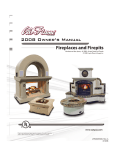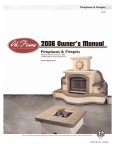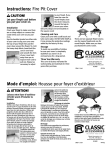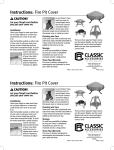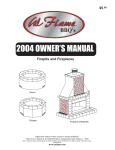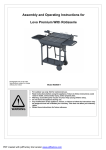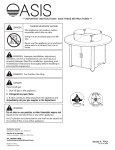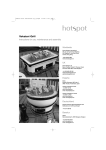Download Cal Flame LTR20091006 Specifications
Transcript
Installation Location . . . . . . . . . . . . . . . . . . . . . . . . . . . . . . . . . . . . . . . . . 5 Leak Testing Procedure . . . . . . . . . . . . . . . . . . . . . . . . . . . . . 6 Liquid Propane (LP) . . . . . . . . . . . . . . . . . . . . . . . . . . . . . . . . 7 Natural Gas . . . . . . . . . . . . . . . . . . . . . . . . . . . . . . . . . . . . . . 10 Fireplace Burner Installation . . . . . . . . . . . . . . . . . . . . . . . . 11 Fire Pit Burner Installation . . . . . . . . . . . . . . . . . . . . . . . . . 13 Fireplace Log Set Placement . . . . . . . . . . . . . . . . . . . . . . . . 15 “Fire on Ice” Glass Placement . . . . . . . . . . . . . . . . . . . . . . . 16 High Elevation Installation . . . . . . . . . . . . . . . . . . . . . . . . . 17 Natural Gas Conversion . . . . . . . . . . . . . . . . . . . . . . . . . . . . 17 Operation Lighting Instructions for Automatic Starter . . . . . . . . . . . . 20 What To Do If You Smell Gas . . . . . . . . . . . . . . . . . . . . . . . . 21 Lighting Your Wood Burning Fireplace . . . . . . . . . . . . . . . . 22 Maintenance Appendix Replacement Parts . . . . . . . . . . . . . . . . . . . . . . . . . . . . . . . . 24 2009 Warranty . . . . . . . . . . . . . . . . . . . . . . . . . . . . . . . . . . . 27 Save these instructions! Copyright 2008-2009 LMS, Inc. All rights reserved. Duplication without written consent is strictly prohibited. Cal Flame ® is a registered trademark. Due to continuous improvement programs, all models, operation, and/or specifications are subject to change without prior notice. LTR20091006, Rev. B 3/30/09 California Proposition 65 Warning: Chemicals known to the State of California to cause cancer, birth defects or other reproductive harm are found in and/or created by the combustion of natural gas, propane, butane and other fuels. Always operate this unit as described in the owner’s manual and in well ventilated areas. Safety Instructions 1 WARNING: Improper installation, adjustment, alteration, service or maintenance can cause injury or property damage. Read the installation, operating and maintenance instructions thoroughly before installing or servicing this equipment. Unless specifically recommended in this manual, do not repair or replace any part of your firepit or fireplace. Have a qualified technician perform all service. Any repairs made by a non-LMS approved dealer technician will void your warranty. Most cities and counties require permits for exterior construction and electrical circuits. In addition, some communities have codes requiring residential barriers such as fencing and/or self-closing gates on property to prevent unsupervised access to the property by children under the age of 5. Your dealer can provide information on which permits may be required and how to obtain them prior to the delivery of your equipment. Placement and Location • Cal Flame fireplaces and firepits are designed for outdoor use only. • Never locate this appliance in a building, garage, or any other enclosed room or under a sealed overhead structure, or in any type of enclosed area such as a garage, shed, or breezeway. Keep clear of trees and shrubs. • Do not place fireplace or fire pit under or near windows or vents that can be opened into your home. • Maintain sufficient distance as to not overheat any overhead combustible material such as a patio cover. • The area surrounding your fireplace or firepit should be kept clean and free from flammable liquids and other combustible materials such as mops, rags or brooms, as well as solvents, cleaning fluids, and gasoline. 2009 Fireplaces and Firepits LTR20091006, Rev. B www.calspas.com Safety Instructions Read this before installing or operating your new Cal Flame firepit or fireplace. Safety Instructions 2 • Do not block the vents located near the base of your firepit or fireplace as gas may build up in case of leak and cause serious damage. • Do not install or operate your fireplace in such a manner that the cross ventilation openings are blocked. Fresh air must be able to pass though installed vents to safeguard against residual gas accumulation. Failure to allow proper ventilation may cause fire or explosion. • Do not locate appliance where it can get excessively wet. Do not use this appliance if any part has been underwater. Immediately call a qualified service technician to inspect the unit and to replace any part of the control system and any gas control which has been underwater. Set-Up • You are responsible for ensuring that a natural gas line (if required) is installed and safe for use. We recommend that a licensed contractor install your fireplace or firepit. Installation must conform to local codes, or in the absence of local codes, with either the National Fuel Gas Code, ANSI Z223.1 / NFPA54, Natural Gas and Propane Installation Code, CSA B149.1, or Propane Storage and Handling Code, B149.2), as applicable. • Do not use an extension cord to supply power to your fireplace or firepit. Such use may result in fire, electrical shock or other personal injury. Do not install a fuse in the neutral or ground circuit. A fuse in the neutral or ground circuit may result in an electrical shock hazard. Do not ground this appliance to a gas supply pipe or hot water pipe. Keep any electrical supply cords and the fuel supply hose away from any heated surfaces. • To prevent fire and smoke damage, remove all packaging material before operating the fireplace or firepit. Operation • Do not use charcoal or other solid fuel in gas burning fireplaces and fire pits. • Do not use your firepit or fireplace for cooking. • In the event that a burner goes out, turn burner knobs to the full OFF position and let it air out. Do not attempt to use the firepit or fireplace until the gas has had time to dissipate. 2009 Fireplaces and Firepits www.calspas.com LTR20091006, Rev. B 3 Keep all electrical supply cords away from the heated areas of the fireplace or firepit. • Never use the fireplace or firepit in windy conditions. If used in a consistently windy area a windbreak will be required. Always adhere to the specified clearances listed in this manual. • When handling LP gas line and connectors, do not allow them to come in contact with any metal surfaces. Do not drop LP connectors. • LP gas sources to the fireplace or firepit must be regulated. Do not operate if regulator has been removed. Fire or explosion can occur. • Never leave the fireplace or firepit unattended when in use. • Never allow clothing or other flammable materials come in contact with any hot surface until it has fully cooled. Never wear loose fitting or hanging garments while using your fireplace or firepit. Fabric may ignite and result in personal injury. • Clothing or other flammable materials should not be hung from the appliance, or placed on or near the appliance. • When using the firepit or fireplace, do not touch the rock, fire screen, or immediate surroundings, as these areas become extremely hot and could cause burns. • Do not heat any unopened glass or metal container of food in the fireplace or firepit. Pressure may build up and cause the container to burst, possibly resulting in serious personal injury or damage to the fireplace or firepit. • Do not reach over your firepit when hot or in use. • Never line firepit or fireplace with aluminum foil. Maintenance and Repair • Spiders and other insects can nest in the burners and block the gas and airflow to the burner ports. This creates a dangerous condition that can result in a fire from behind the valve panel. Inspect and clean the burners periodically and follow the guidelines in the maintenance section of this manual. • The appliance should be inspected before use and at least annually by a qualified service person. 2009 Fireplaces and Firepits LTR20091006, Rev. B www.calspas.com Safety Instructions • Safety Instructions 4 • More frequent cleaning may be required as necessary. It is imperative the control compartment, burner and circulation air passageways of the appliance be kept clean and free. • Any guard or other protective device removed for servicing the appliance must be replaced prior to operating the appliance. • If it is evident there is excessive abrasion or wear of any of the components, if the fuel supply hose is cut or cracked, it must be replaced prior to the appliance being put into operation. • Inspect the fuel supply connection for signs of leakage (including the hose for LP models) before each use of the appliance. Storage • When your fireplace or firepit is not in use, turn off the gas at the source. • Do not store the liquid propane (LP) cylinder in the vicinity of this or any other appliance when it is not being used. • This appliance can be store indoors only if it has been disconnected from its fuel supply. • Store LP gas cylinders outdoors in a well-ventilated area out of reach of children. Disconnected sylinders must have threaded valve plugs tightly installed and must not be stored in a building, garage, or any other enclosed area. • To extend the life of your fireplace or firepit, protect and cover it from the elements when not in use. Ensure the appliance has ample time to cool off after use and prior to installing storage cover. Damage caused to storage cover due to heat or burns are not covered by warranty. Precautions Regarding Children • Never leave children unattended in the area where the fireplace or fire pit is being used. Close supervision of children is necessary when any appliance is used near children. • Do not store items of interest to children around or below the fireplace or fire pit. • Never allow children to sit or stand on any part of the fireplace or fire pit. 2009 Fireplaces and Firepits www.calspas.com LTR20091006, Rev. B Installation 5 Installation must conform with local building and/or fire codes, or in the absence of local codes: • National Fuel Gas Code ANSI Z223.1 / INFPA 54 (for installation in the United States) • CSA B149.1 Natural Gas and CAN/CGA-BIL/9-2, Propane Installation code (for installation in Canada). Location Place your firepit or fireplace on a flat and stable surface in an outdoor location such as a patio deck. Do not locate the appliance where it can get excessively wet or submerged in water. When determining a suitable location, take into account concerns such as exposure to wind, proximity to traffic paths, and windows that open into the home. Locate your firepit or fireplace adjacent to the gas supply line (LP or NG), preferably with the shortest gas line run possible. Maintain the following clearances to combustible materials on all Cal Flame fireplaces and fire pits. Measure from the outside of the unit. Sides (all around) 48 inches (1.2 m) Top 72 inches (1.8 m) Your Cal Flame firepit or fireplace is designed and intended for OUTDOOR USE ONLY in a well ventilated space and must not be used inside a building, garage, or any other enclosed area. 2009 Fireplaces and Firepits LTR20091006, Rev. B www.calspas.com Installation / Assembly Installation and service must be performed by a qualified installer, service agency or your natural gas or liquid propane (LP) gas provider. Installation / Assembly 6 Leak Testing Procedure Perform a leak test at least once a year whether the gas supply cylinder has been disconnected or not. In addition, whenever the gas cylinder is connected to the regulator or whenever any part of the gas system is disconnected or replaced, perform a leak test. As a safety precaution, remember to always leak test your fireplace or firepit outdoors in a well-ventilated area. Never smoke or permit sources of ignition in the area while doing a leak test. Do not use a flame, such as a lighted match to test for leaks. Use a solution of soapy water. 1. Prepare a leak testing solution of soapy water by mixing in a spray bottle one part liquid soap to one part water. 2. Make sure all the control knobs are in the OFF position. 3. Turn on the gas. On natural gas systems, turn the main feed valve to the burner. On LP systems, turn the cylinder valve knob counter clockwise one turn to open. 4. Apply the leak-testing solution by spraying it on joints of the gas delivery system. Blowing bubbles in the soap solution indicates that a leak is present. 5. Stop a leak by tightening the loose joint or by replacing the faulty part with a replacement part recommended by the manufacturer. Do not attempt to repair the cylinder valve if it is damaged. The cylinder must be replaced. 6. Turn the control knob back to the full OFF position. If you are unable to stop a leak: 1. Turn the control knob back to the full OFF position. 2. Shut off the gas supply to the fireplace or firepit and release pressure in the hose and manifold by turning the control valve one quarter turn counter-clockwise. 3. On LP systems, remove the cylinder from the fireplace or firepit. 4. Call an authorized gas appliance service technician or an LP gas dealer. Do not use the appliance until the leak is corrected. 2009 Fireplaces and Firepits www.calspas.com LTR20091006, Rev. B Liquid Propane (LP) 7 Manifold Pressure: For plumbed-in LP installation, use a regulator. Supply Pressure: Maximum line pressure for plumbed-in propane is 14” W.C psi (3.5 kPa). Minimum line pressure for propane is 11” W.C. Pressure Regulator: The unit must be used with the gas pressure regulator. The regulator will control and maintain a uniform gas pressure in the manifold. The burner orifice has been sized for the gas pressure delivered by the regulator. Cylinder Specification: Any LP gas supply cylinder used with this firepit or fireplace must be approximately 12 inches in diameter and 18 inches high. The maximum fuel capacity is 20 lbs. of propane, or 5 gallons. Full cylinder weight should be approximately 38 lbs. (43.7 lbs. nominal water capacity.) Always use the cylinder dust cap on the cylinder valve outlet during transport and when the cylinder is not connected to the firepit or fireplace. Transporting Gas Cylinder: Only one cylinder should be transported at a time. Transport cylinder in an upright and secure manner with control valve turned off and the dust cap in place. Enclosures: Ensure cylinder valves are always readily accessible. A door on the enclosure to gain access to the cylinder valve is acceptable, provided it is non-locking and can be opened without the use of tools. If you build an enclosure for an LP gas cylinder, follow these recommended specifications and follow local codes. Enclosures for LP gas supply cylinders need to be ventilated by openings at the level of the cylinder valve and at floor level. This is accomplished by: 1) Having one side of the enclosure shall be completely open, Or, for an enclosure with four sides, a top and bottom: 2009 Fireplaces and Firepits LTR20091006, Rev. B www.calspas.com Installation / Assembly Requirements The 20 lb LP gas supply cylinder used with LP models must be constructed and marked in accordance with the specifications for LP-gas cylinders as required by the U.S. Department of Transportation (DOT) or the CAN/CSA B339, Cylinders, Spheres and Tubes for the Transportation of Dangerous Goods. Installation / Assembly 8 2) H aving at least two ventilation openings at cylinder valve level in the side wall, equally sized, spaced at 180 degrees (3.14 rad), and unobstructed. Make sure each opening has a total free area of not less then ½ square inch per pound (3.2 sq. cm/kg) of stored fuel capacity and not less then a total free area of 10 square inches (64.5 sq. cm). V entilation openings need to be provided at floor level with a total free area of ½ inch per pound (3.2 sq. cm/k) of stored fuel capacity and not less than a total free area of 10 square inches if the ventilation openings at floor level are in a side wall, make sure there are at least two openings. The bottom of the openings shall be at floor level and the upper edge no more than 5 inches (127 mm) above the floor. The openings need to be equally sized, spaced at 180 degrees (3014 rad) and unobstructed. M ake sure every opening has minimum dimensions to permit the entrance of a 1/8 inch (3.2mm) diameter rod. There shall be a minimum clearance of 2 inches (40.8mm) between the lower surface of the floor and the LP gas supply cylinder enclosure and the ground. Check the rating plate to make sure the gas supply you are hooking up to is the gas type the firepit or fireplace is manufactured for. If you do not have an updated filler valve on your existing propane tank, you will need to purchase one at your local hardware store, as you will not be allowed to refill the tank at any filling station. Use the pressure regulator and hose assembly supplied with LP models. Replacement pressure regulator and hose assemblies must be those specified in this manual. The 20 lb LP gas cylinder used must include a collar to protect the cylinder valve. Be certain to mount or set the 20 lb LP gas cylinder on a flat surface and restrain it to prevent it from tipping. 2009 Fireplaces and Firepits www.calspas.com LTR20091006, Rev. B 9 When connecting the regulator assembly to the tank valve, hand tighten the black QCC-1 nut clockwise. DO NOT use a wrench to tighten. See the figure below. Purge the gas supply line of any trapped air prior to the first firing of the unit. During the initial purging and subsequent lightings, NEVER allow gas to remain in the “Open” position without first placing and igniting the fire starter. Locate the hose out of the pathways where people may trip over it or in areas where the hose may be subjected to accidental damage. 2009 Fireplaces and Firepits LTR20091006, Rev. B www.calspas.com Installation / Assembly Connection Inspect the hose shipped with the unit for damage. Never attempt to use damaged or plugged equipment. See your local LP gas dealer for repairs. After inspecting the LP hose shipped with the unit, connect the end with the female fitting on the hose to the male fitting on the on/off gas valve at the end of the hose. Tighten fittings using two wrenches. Installation / Assembly 10 Natural Gas The appliance and its individual shut off valve must be disconnected from the gas supply piping system during any pressure testing of the system at test pressures in excess of ½ psig (3.5kPa). This appliance must be isolated from the gas supply piping system by closing its individual manual shut off valve during any pressure testing of the gas supply piping system at test pressures equal to or less than 1/2 psig (3.5kPa). Requirements Always check the rating plate to make supply you are hooking up to is the firepit or fireplace is manufactured for. sure the gas type gas the The installation of this appliance must conform with local codes or, in the absence of local codes, to the national fuel gas code, ANSI Z223.1a-1998. Installation in Canada must be in accordance with the standard CAN/CGA-B149.2, Propane Installation Code. Natural gas connection must be performed by a licensed contractor or local gas company representative. Ensure that the service supplying the firepit or fireplace is fitted with a conveniently positioned shut off valve with easy access. Installation Connect the incoming gas supply line to the on/off gas valve of the appliance. Make certain ALL gas connections are tight, turn the on/ off valve at the unit to the ‘on’ position and use soap and water to test for leaks. Gas will be released at the burner for this duration. DO NOT USE AN OPEN FLAME AND REMOVE BATTERY FROM IGNITER BEFORE PERFORMING THIS TEST. An authorized gas appliance installer must provide this installation service. Note that the correct natural gas orifice must also be installed prior to fuel line hook up to maintain proper flame height and clean burn of fuel. 2009 Fireplaces and Firepits www.calspas.com LTR20091006, Rev. B 11 This procedure describes how to access the gas lines for installation. Gas installation should be performed by a qualified contractor. 1. Slide the hearth base out of the fireplace. 2. Pull the gas flex line through the slot in the hearth base and connect it to the burner. 3. Slide the burner into the slot in the hearth base. 2009 Fireplaces and Firepits LTR20091006, Rev. B www.calspas.com Installation / Assembly Fireplace Burner Installation Installation / Assembly 12 4. While holding the burner in place, extend the wire from the burner to the sparker switch located on the right side of the fireplace. Connect the wire to the electric sparker. 5. Slide the hearth base back into the fireplace. 2009 Fireplaces and Firepits www.calspas.com LTR20091006, Rev. B 13 The log set and crushed lava rock are shipped together on applicable models. Remove the log set and un-pack all components. The logs are fragile -- use care when handling. Turn the fire pit on its side. Connect the piezoelectric starter and attach the flex hose for the gas supply. Place the fire pit back down on its pedestal. Attach the gas flex hose to the burner. Note: If you want to convert the orifice from LP to NG, this is location of the orifice. See next page for gas converstion instructions. 2009 Fireplaces and Firepits LTR20091006, Rev. B www.calspas.com Installation / Assembly Fire Pit Burner Installation Installation / Assembly 14 Set the burner in the center of the pit. Place the rocks on top of and around the burner. Arrange the log set on top. 2009 Fireplaces and Firepits www.calspas.com LTR20091006, Rev. B 15 The log set, log grate and crushed lava rock are shipped together on applicable models. Remove the log set and un-pack all components. The logs are fragile -- use care when handling. Once the fireplace is in position, level and safely hooked up to the proper fuel supply, install the log grate over the plate burner. Place the lava rock around the flat burner plate. DO NOT place the lava rock on the burner plate as it will affect the flow of the flame. Place the ceramic fire logs on the grate. Start by laying one log in the center of the grate length wise. Lay the other logs (quantity may vary by unit type) over the first log as shown below. NOTE: Be sure unit is cool before touching any of the components. Place two logs lengthwise in the grate and position remaining logs over them in an angled position as shown. Ensure the logs are placed securely to avoid any movement. 18” Log Set 24” Log Set 2009 Fireplaces and Firepits LTR20091006, Rev. B www.calspas.com Installation / Assembly Fireplace Log Set Placement Installation / Assembly 16 “Fire on Ice” Glass Placement Some fire pit owners have the “Fire on Ice” option which uses decorative glass chips instead of lava rocks and a log set. (This option is available to all fire pit owners and may be ordered directly from Cal Flame. See page 25 for order information.) You will receive two bags of different colored glass. Open the bag of lighter colored glass and pour it into the shallow pit on top of and around the burner. Distribute the glass in an even layer. Then open the bag of darker colored glass and pour it into the center of the fire pit as shown in the figures below. This will create an attractive two-tone effect. 2009 Fireplaces and Firepits www.calspas.com LTR20091006, Rev. B 17 Your fireplace or fire pit is approved for elevations up to 4500 feet in the US and Canada. When installing this appliance at an elevation above 4500 feet in the US, it may be necessary to decrease the input rating by changing the existing burner orifice to a smaller size. Reduce the input by 4% for each 1,000 feet above sea level, unless the heating value of the gas has been reduced, in which case this general rule will not apply. To identify the proper orifice size, check with your local gas utility. When installing this unit at an elevation above 4,500 feet in Canada check with your local authorities. Consult the local gas utility for assistance in determining the proper orifice for your location. Natural Gas Conversion For Both Fireplaces or Fire Pits CAUTION: This service is to be completed only by an authorized gas appliance installer. Do not attempt this conversion on your own as there is risk of serious injury or death. To The Authorized Gas Appliance Installer: All Cal Flame fireplaces and firepits are shipped from the factory equipped to burn on liquid propane fuel. Enclosed with this kit is a natural gas conversion kit for converting this unit to natural gas. To perform this conversion, follow the directions below and to the local regulation standards in your area. 1. Make sure unit is not in operation and is cool enough to perform this service. Shut off and disconnect propane fuel source at the regulator end. 2. Carefully remove the storage cover, lava rocks and fire logs. Turn unit over to access hose connections underneath. 3. While holding the propane orifice in place with a wrench, unscrew brass fitting on fuel inlet hose. Unscrew propane orifice and remove. 4. Using the new brass natural gas orifice re-install the parts in the same sequence. Turn the protective screen / air intake sleeve to al2009 Fireplaces and Firepits LTR20091006, Rev. B www.calspas.com Installation / Assembly High Elevation Installation Installation / Assembly 18 low a controlled amount of air flow through the screen and into the fuel supply tube. Flame should have good retention. For a proper burn and as a general rule, the air shutter for propane installation should be completely open, and the air shutter for NG installation should be mostly closed. This can be adjusted later to create a clean and desired flame. 5. Refer to photo below for proper placement of parts. The washer should insert next to the protective screen cover, then the spring is to be aligned with the hole and finally the natural gas orifice is to be threaded into the end of the fuel inlet leading into the burner. Once tight the other brass fitting connection can be made from the fuel line fitted between the valve and the orifice. 6. Connect natural gas supply hose (not included with kit) from supply source. Test for leaks. 7. Once the conversion is completed and leak tested, reload the fireplace or firepit with the lava rocks and fire logs. Test the unit while in place and verify it works properly. If flame from burner is not properly adjusted you can adjust air intake by turning the protective screen cover and air intake sleeve on the fuel supply tube. Orifice assembly for fire pit burners Orifice assembly for fireplace burners 2009 Fireplaces and Firepits www.calspas.com LTR20091006, Rev. B Operation 19 Upon completing the gas line connection, a small amount of air will be in the lines. When the first lighting the burner, it will take a few seconds for the lines to purge themselves of this air. Once the purging is complete, the burner will light and operate as indicated in the instruction manual. Subsequent lighting of the appliance will not require purging unless the gas supply has been disconnected. Always keep the appliance area clear and free from combustible materials, gasoline and any other flammable vapors and liquids. Inspect the burner before each use of the appliance. If there is any evidence that the burner is damaged, it must replaced before operating. Upon completing the gas line connection, a small amount of air will be in the lines. When first lighting the burner, it will take a few minutes for the lines to purge themselves of this air. Subsequent lighting of the appliance will not require such purging. Never allow the ON / OFF valve to remain in the open position without placing a burning match on top of the burner FIRST! You must have clear and easy access to the ON / OFF valve AFTER the appliance is installed and connected to the gas supply in order to safely turn of the burner. If you do not follow these instructions exactly, a fire or explosion may result, causing property damage, personal injury, or loss of life. Make sure the burner is in place prior to using the appliance. If the burner is damaged, install a replacement burner as specified by the manufacturer. For your safety, read before lighting. • Before operating smell all around the appliance area for gas odors and next to the floor because some gases are heavier then air and will settle on the floor. • Use only your hand to turn the manual gas control valve. Never use tools. If the valve will not turn by hand, do not try to repair it. Call a qualified service technician. Force or attempted repair may result in a fire or explosion, 2009 Fireplaces and Firepits LTR20091006, Rev. B www.calspas.com Using Your Grill WARNING: DO NOT use solid fuel, such as wood or charcoal, in gas fueled fireplaces or fire pits. Using Your Grill 20 • Do not use this appliance if any part has been under water. Immediately call a qualified service technician to inspect the appliance and replace any part of the control system and any gas control which has been under water. • Make sure the ignitor battery has been installed properly. Ignitor will not operate properly without a battery installed. Lighting Instructions for Automatic Starter 1. Remove protective storage cover and locate the manual gas control valve and igniter button on the fireplace. 2. Make sure fuel supply is properly connected and turned on at the source. 3. Depress igniter button until you hear it sparking. You will hear a small popping noise. Keep igniter button pushed in while slowly turning the fuel flow valve to the full flow position at the fireplace. The fireplace should light within 5 seconds. If you do not hear the igniter sparking you may need to replace the battery. The starter uses one standard AAA battery, located directly behind the rubber push button knob. (Unscrew knob to access battery.) Note some models ship with the batteries removed or may not be included with your model. 4. If a flame does not start within 10 seconds, shut off all gas supply and wait five minutes to allow all gas fumes to clear. Re-try or go to trouble-shooting and start again from step 1. 2009 Fireplaces and Firepits www.calspas.com LTR20091006, Rev. B 21 Turn the ON/OFF valve to the off position at the unit for natural gas unit. For LP unit, turn the ON/OFF valve to the OFF position at the unit and then turn the valve on the LP tank to the OFF position clockwise. NOTE The propane regulator in this appliance is equipped with a low flow protection device. Unless the propane cylinder valve is opened before the valve, the gas flow will be reduced resulting in a very small flame. To reset this device, shut off the valve, disconnect the hose from the cylinder to relieve the pressure, then close the propane cylinder valve. Follow the lighting procedure ensuring the propane cylinder valve is opened before the unit is. What To Do If You Smell Gas • Shut off gas to the firepit or fireplace. • Extinguish any open flame. • Do not try to light the appliance. • Do not touch any electric switch. Do not use any phone in the immediate area. • If odor continues, keep away from the appliance and immediately call your gas supplier or your fire department. 2009 Fireplaces and Firepits LTR20091006, Rev. B www.calspas.com Using Your Grill To Turn Off Gas Using Your Grill 22 Lighting Your Wood Burning Fireplace Your wood burning fireplace is designed to use a grate to hold the wood to be burned approximately 2”-3” off the base. This allows air to get to the bottom of the wood and gives room for ash to accumulate. Do not attempt to burn wood in your appliance without a proper grate installed. WARNING: Never use liquids such as gasoline or lighter fluid in a wood burning fireplace. Serious injury can occur. Have several sizes of wood available. Small pieces will be needed to start the fire, some medium sizes and finally larger logs that will burn for a longer period of time. Make sure all logs are small enough to fit entirely into the fireplace or firepit. If the wood is too large, cut or split it until it will fit into the enclosure. 1. Wad up some dry newspaper and put it under the grate but be carefull of ash that may be under grate from a previous fire. 2. Put small pieces of wood over the newspaper, on the grate. Small wood should not be more than 1/2” thick and 1” wide. Smaller wood will burn easier and make the fire easier to start. Make sure to leave room for air to circulate around the small pieces of wood. 3. On top of the small pieces of wood put a few medium sized pieces of wood. These pieces can be from 1” to 2” thick but should not block airflow around the small pieces. 4. Light the newspaper under the grate in several places. As wood begins to burn, add more medium sized pieces one at a time until a good coal base is formed. At this time you can add larger pieces of wood. Always make sure there is sufficeint room for air to flow around the wood that is added or you may smother your fire. Warning! Never leave a burning fireplace or firepit unattended! 2009 Fireplaces and Firepits www.calspas.com LTR20091006, Rev. B 23 Inspect the appliance before initial use. Clean the appliance at least annually and have it inspected by a qualified field service person. Periodically remove the logs and examine the burner. If the burner is dirty, clean it with a soft wire brush. Also examine the area around the burner air shutter. Remove any dirt or debris in this area. This will ensure long life and trouble-free operation. Periodically check the hose connecting the LP gas cylinder to ensure it is not damaged in any way. Carbon (soot) may build up on the surfaces of the logs with heavy use. This is more likely to occur with LP gas. Clean soot off the surface of the logs periodically to prevent excessive buildup. To clean the logs, be sure the fire is out, the gas supply is turned off and the logs are cool to the touch. The soot can then be brushed of with a dry bristle brush or cloth. Take care while cleaning the logs as they can become damaged if mishandled. Periodically check the hose connecting the LP gas cylinder to ensure it is not cracked or damaged in any way. All natural gas hook-ups should be serviced and inspected only by qualified installers only. The easiest way to clean the firepit or fireplace is to let the firepit/ fireplace cool completely off. • With a wood burning fireplace, remove the steel grate and sweep out the ashes and leftover kindling. • With a gas firepit or fireplace, spray the enclosure off with water. Note: Do NOT spray water directly onto the burner and pilot light of the gas fireplace. When not in use and after cooling, cover your firepit with our full length, zippered side canvas cover. The cover will help protect your firepit/fireplace from detrimental effects of weather and environmental pollutants (see your local Cal Flame dealer for details). Before installing the cover make sure the unit is shut off, that the gas lines are disconnected and that the unit has had sufficient time to cool. Install the cover and use the tie-down straps to secure it tightly to the unit to prevent the wind from blowing it off. 2009 Fireplaces and Firepits LTR20091006, Rev. B www.calspas.com Cleaning and Maintenance Maintenance Appendix 24 Appendix Replacement Parts Call 1-800-CAL-SPAS for any replacement parts not listed below. Be sure to have model name and number available. Fireplace Parts 18” Log Set BBQ08000610 24” Log Set BBQ08000620 18” Grate BBQ08210650 Square Burner BBQ07210005 Rectangle Burner BBQ04100076 Metal Plate BBQ04100075 30” Arch OPT940 BBQ08210577 30” Igloo Box BBQ08210575 30” Base-Igloo Box BBQ08210576 36” Arch BBQ08210584 36” Igloo Box BBQ08210587 36” Base-Igloo Box BBQ08210586 36” Arch BBQ08210584 36” Back Panel BBQ08210572 36” Base Panel BBQ08210570 36” Side Panel BBQ08210571 36” Sheet Metal Fire Box BBQ08210583 Mantle Piece BBQ08210612 22” Vent Piece BBQ08210610 Front Hearth Piece BBQ08210611 Front Hearth Piece BBQ08210607 Left Side Hearth Piece BBQ08210604-L Right Side Hearth Piece BBQ08210604-R NG Orifice .125 BBQ04100077 Propane Orifice #43 BBQ04100078 2009 Fireplaces and Firepits www.calspas.com LTR20091006, Rev. B 25 NG Orifice .125 BBQ04100077 Propane Orifice #43 BBQ04100078 Replacement Crushed Lava Rock Kit FP0100 Replacement Fire Pit Electronic Igniter FP0102 Replacement Fire Pit Gas Control Knob FP0103 Replacement Fire Pit Propane Fuel Hose With Regulator FP0104 Fire On Ice, 3/8” Peridot, Fire Glass Crys- BBQ04100065 tals, 20 lbs/bag Fire On Ice, 1/4” Standard, Sapphire, Fire BBQ04100066 Glass Crystals, 10 lbs/bag Fire On Ice, 1/4” Standard, Malachite, Fire BBQ04100067 Glass Crystals, 10 lbs/bag Fire On Ice, 1/4” Standard, Onyx, Fire BBQ04100068 Glass Crystals, 10 lbs/bag Fire On Ice, 1/4” Standard, Topaz, Fire BBQ04100069 Glass 2009 Fireplaces and Firepits LTR20091006, Rev. B www.calspas.com Appendix Firepit Parts Appendix 26 Specifications Fireplace Specifications LP Gas Natural Gas 51,037 55,000 #42 (0.0860) #26 (0.147) Manifold Pressure 10” Water Column 7” Water Column Maximum Gas Supply Pressure 11” Water Column 7” Water Column Maximum Inlet Supply Pressure 13” Water Column 7” Water Column Regulator Pre-Set 11” Water Column 3.5” Water Column Max. Input BTU/ Hr Orifice Size Fire Pit Specifications Max. Input BTU/ Hr Orifice Size LP Gas Natural Gas 51,037 55,000 #42 (0.0860) #26 (0.147) Manifold Pressure 10” Water Column 7” Water Column Maximum Gas Supply Pressure 11” Water Column 7” Water Column Maximum Inlet Supply Pressure 13” Water Column 7” Water Column Regulator Pre-Set 11” Water Column 3.5” Water Column 2009 Fireplaces and Firepits www.calspas.com LTR20091006, Rev. B 27 2009 Warranty L.M.S. warrants the fire pits and fireplaces from defects in material and workmanship for a period of one year from the original date of purchase. All stainless steel components are warranted against defects for two years from date of purchase. All other parts (such as igniter, hose assembly, etc.) are covered and Cal Flame will provide replacement parts free of charge during the first year of the limited warranty. To obtain replacement warranty parts, call your Cal Flame dealer and be prepared to provide proof of purchase via fax or mail. Parts will be shipped at no charge. Labor related to warranty repair is not covered. Any repair work must be done through an authorized Cal Flame dealer. In the first year only, this warranty extends to the repair or replacement of warranted parts which are defective in material or workmanship provided that the product has been operated in accordance with the operation instructions and under normal conditions. Warranty Conditions and Limitations The Limited Warranty is void if the fire pit or fireplace has been subject to negligence, alteration, misuse, abuse, repairs by non-L.M.S. authorized representatives, incorrect electrical installation, acts of God and any other cases beyond the control of L.M.S. Examples of common acts invalidating this warranty include but are not limited to: • • • • • • • • • • • Scratches caused by normal use. Damage caused by extreme weather conditions (heat, cold, etc.). Damage caused by dirt, sand, and/or water damage. Damage caused by continued operation of the fire pit or fireplace with either known or unknown problems. Damage caused by direct sunlight. Damage caused as a result of failure to follow the operating instructions as defined in this owner’s manual. Misuse Lack of maintenance Accident Alterations Abuse 2009 Fireplaces and Firepits LTR20091006, Rev. B www.calspas.com Appendix See your Cal Flame dealer for a copy of the applicable warranty, details and any questions you may have regarding the warranty coverage on your fire pit or fireplace. Appendix 28 • • • • Neglect The use of components not supplied with the appliance The use of fuel other than those specified Weather, including freezing damage, long periods of dampness, or condensation • Damaging chemical or cleaners • Parts installed from other manufacturers This Limited Warranty applies only to fire pits or fireplaces normally used for personal, family, or household purposes and specifically excludes commercial fire pits or fireplaces. Cal Flame warrants its products against manufacturing defects of the original purchaser only, (i.e., the individual, legal entity or registered customer whose name appears on the original receipt or warranty card filed with Cal Flame) – provided that the purchase was made through an authorized Cal Flame dealer and is subject to the following condition and limitations: • This limited warranty applies only while the unit remains at the site on original installation and only if the unit is installed in Canada or the United States. • This factory warranty is nontransferable and may not be extended whatsoever by any of our representatives. • Installation must be done in accordance with the installation instruction included with the product and all local and national building and fire codes. Natural gas units must be installed by an authorized gas appliance technician. • The original bill of sale will be required together with a model number when making any warranty claims from your authorized dealer. The warranty registration card (if included with kit) must be returned within 30 days of purchase to register the warranty. Warranty Exclusions Fire pit and fireplace stereo systems are delivered with their own manufacturer’s warranty. For more information, see their warranties in the owner’s information package that was delivered with your fire pit or fireplace for more information. Fire logs carry no warranty. 2009 Fireplaces and Firepits www.calspas.com LTR20091006, Rev. B 29 Appendix 2009 Fireplaces and Firepits LTR20091006, Rev. B www.calspas.com CONTACT INFORMATION For customer service, please contact your authorized dealer immediately. If you need additional information and/or assistance, please contact: Customer Service Department 1462 East Ninth Street Pomona, CA 91766 Toll Free: 1-800-CAL-SPAS Fax: 1-909-629-3890 www.calspas.com LTR20091006, Rev. B 3/30/09

































